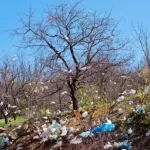£80 billion eco-friendly ‘Forest city’ is now a complete ghost town
The post £80 billion eco-friendly ‘Forest city’ is now a complete ghost town appeared first on Healthy Holistic Living.
In the realm of urban innovation, the concept of an eco-friendly “Forest City” emerged as a groundbreaking endeavor, promising to redefine the standards of sustainable living. Envisioned as a $100 billion (£80 billion) utopia on the southern coast of Malaysia, Forest City was designed to be a haven for up to a million people, boasting amenities like a golf course, water park, and diverse dining options, all nestled within a verdant landscape. This ambitious project aimed not just at architectural and environmental milestones but also at fostering a vibrant community in harmony with nature.
However, the reality that unfolded tells a starkly different story. Despite its grand beginnings in 2016, Forest City has evolved into something reminiscent of a modern-day ghost town. With only about 15 percent of the development completed and an occupancy rate hovering around one percent, the dream of a bustling eco-metropolis seems to be dissolving into the mists of unattained aspirations. This article seeks to unravel the narrative of Forest City, examining the divergence between its envisioned future and the present-day challenges that have led to its current state of eerie silence and abandonment.
The Rise and Stumble of Forest City
In 2016, the groundbreaking of Forest City marked the beginning of what was anticipated to be a monumental leap towards sustainable urban living. The project, spearheaded by Chinese property developer Country Garden, promised to transform a vast coastal area in southern Malaysia into an eco-friendly megacity. It was a vision of the future where up to a million residents could live in harmony with nature, enjoying the luxuries of modern amenities while contributing to an environmentally sustainable world. The city was to be a showcase of innovation, with green buildings, renewable energy sources, and a smart transport system, all designed to minimize the ecological footprint of its inhabitants.
As construction progressed, however, the reality of the ambitious project began to diverge significantly from its initial promise. Only a fraction of the planned development was realized, with just about 15 percent of the city built. What had been constructed stood largely empty, a silent testament to the challenges that had beset Forest City from its inception. The vision of bustling streets and lively community spaces gave way to the reality of vacant apartments and underused facilities, casting a shadow over the project’s future.
The stark contrast between the initial hype and the current state of Forest City raises questions about the viability of such grandiose projects. Despite the optimistic projections of its developers, the city struggled to attract residents and investors. The high cost of living in Forest City, combined with its relatively isolated location, made it inaccessible to the majority of Malaysians and unappealing to the targeted demographic of Chinese buyers seeking a second home abroad. The onset of the COVID-19 pandemic further exacerbated these issues, halting construction and stifling any potential growth in occupancy rates.
Economic and Social Challenges
The vision of Forest City as an eco-friendly paradise was not just hampered by its ambitious scale but also by a series of economic and social challenges. The project’s financing became a subject of concern early on. Country Garden, the Chinese property developer behind Forest City, found itself grappling with a staggering debt of almost $200 billion (£160 billion). This financial strain raised doubts about the company’s ability to complete the vast development as planned. Skepticism grew as the reality of the financial challenges became apparent, with many wondering if the dream of Forest City was too big to be realized. The development’s reliance on property sales to fund further construction meant that any stagnation in the real estate market directly impacted its progress.
Socially, the project also faced significant hurdles. The target demographic, primarily wealthy Chinese investors seeking luxury second homes, did not materialize in the numbers anticipated. Furthermore, the high price point of properties in Forest City put them out of reach for most Malaysian citizens, creating a disconnect between the development and the local community. This gap was not just financial but also cultural and social, as the project did little to integrate with the surrounding areas or address the needs of the local population. The resulting lack of community engagement and sense of belonging contributed to the ghost town atmosphere, as vast sections of the city remained uninhabited and lifeless.
The impact of the COVID-19 pandemic cannot be overstated. Travel restrictions and economic uncertainties led to a decline in international property investments, severely affecting Forest City’s sales and halting its development momentum. The pandemic underscored the vulnerabilities of relying heavily on the global real estate market for the success of such an ambitious project. As construction slowed and the world economy faced unprecedented challenges, the future of Forest City hung in balance, with its deserted streets and empty buildings serving as a reminder of the fragility of mega-development projects in the face of global crises.
Reimagining Forest City: A Path Forward
Despite the challenges and setbacks, the story of Forest City is not yet concluded. There lies a potential path forward, one that requires a reevaluation of the project’s goals and strategies to adapt to the changing realities of the global real estate market and the needs of the local community. For Forest City to evolve from a ghost town into the thriving eco-city it was meant to be, a comprehensive approach focusing on sustainability, inclusivity, and community engagement is essential.
Firstly, addressing the affordability and accessibility of housing within Forest City could help to attract a broader demographic. Implementing mixed-use development strategies that include affordable housing options could invite more residents and create a more diverse community. This approach would not only help in populating the city but also in fostering a sense of belonging and community among its inhabitants. Furthermore, leveraging the already built eco-friendly infrastructure by promoting green technologies and sustainable living practices can enhance Forest City’s appeal to environmentally conscious buyers and investors.
Secondly, enhancing the integration with the local economy and culture is crucial. Forest City should look beyond its borders and seek ways to contribute to the wider region’s economic and social fabric. This could involve creating job opportunities for locals, supporting local businesses, and hosting cultural exchange programs. Such initiatives could bridge the gap between Forest City and the surrounding Malaysian community, creating a mutual benefit scenario where the city’s growth positively impacts the region.
Lastly, repositioning Forest City in the post-pandemic world requires innovative marketing and a clear vision that resonates with potential residents’ and investors’ current priorities. Emphasizing the city’s unique qualities, such as its commitment to sustainability and its state-of-the-art amenities, could rekindle interest. Additionally, exploring new avenues such as becoming a hub for remote workers, a center for eco-tourism, or a pioneer in green technology could redefine Forest City’s identity and purpose.
The journey of Forest City highlights the complexities and uncertainties of ambitious urban development projects. Yet, within its quiet streets and unoccupied buildings, there lies a lesson in resilience and adaptability. By reimagining its future, Forest City can still transform into a symbol of sustainable living and a testament to the power of human ingenuity and perseverance in the face of adversity.
Revitalizing Community Engagement and Local Integration
For Forest City to transition from an ambitious blueprint to a living, breathing urban ecosystem, revitalizing community engagement and fostering deeper integration with the local milieu are pivotal. This involves not just infrastructural or economic adjustments, but a holistic reimagining of how the city interacts with its inhabitants and the surrounding communities. The emphasis should be on creating a vibrant, inclusive environment that caters to diverse needs and preferences, bridging the gap between the initial vision and the current reality.
Building a Multifaceted Community Center
Developing a central community hub within Forest City could serve as a catalyst for social interaction and cultural exchange. This space should offer a variety of activities and services that appeal to all age groups and interests, from recreational facilities and educational workshops to art galleries and community gardens. By hosting regular events, such as farmers’ markets, cultural festivals, and sports tournaments, Forest City can foster a sense of community and encourage residents to engage with their city and each other more actively.
Enhancing Local Economic Opportunities
Integrating Forest City with the local economy is essential for its sustainability and growth. Initiatives could include supporting local entrepreneurship by providing platforms for small businesses and startups to thrive within the city. Establishing partnerships with local universities and research institutions could also drive innovation and development, positioning Forest City as a hub for technological and environmental research. These efforts not only stimulate the local economy but also create job opportunities for residents, enhancing the city’s appeal as a place to live and work.
Promoting Cultural and Environmental Education
Education plays a crucial role in integrating and engaging communities. Forest City has the unique opportunity to pioneer environmental education and sustainable living practices among its residents and visitors. This could be achieved through interactive exhibits, workshops, and seminars that focus on eco-friendly technologies, biodiversity conservation, and sustainable urban planning. Cultivating a culture of environmental stewardship and innovation can inspire residents to contribute actively to their city’s sustainability goals, creating a ripple effect that extends beyond its borders.
The transformation of Forest City into a dynamic and integrated community requires concerted efforts across multiple fronts. By prioritizing community engagement, local integration, and sustainability, Forest City can redefine its narrative from a ghost town to a model of modern, eco-conscious living. Such a shift not only reinvigorates the city itself but also serves as a blueprint for future urban development projects around the world.
Rekindling the Spirit of Forest City
The journey of Forest City, from its inception as an eco-utopian dream to its current reality as an underpopulated ghost town, serves as a powerful narrative about the complexities of realizing mega urban projects. Yet, within this narrative lies a profound opportunity for transformation. By pivoting towards a more inclusive, sustainable, and community-focused development model, Forest City can still achieve its original vision of becoming a beacon of modern, eco-conscious living. The path forward requires not only the adoption of green technologies and sustainable living principles but also a deep commitment to fostering community engagement, local integration, and economic resilience.
The potential rebirth of Forest City as a vibrant, thriving eco-city is emblematic of the broader challenges and opportunities facing urban development worldwide. It underscores the necessity of balancing ambitious architectural and environmental goals with the practical realities of social, economic, and ecological sustainability. The lessons learned from Forest City can inform future projects, encouraging a holistic approach that prioritizes the well-being of the environment and its inhabitants.
In the end, Forest City stands at a crossroads. With the right strategies, it can move beyond its past struggles and emerge as a testament to human ingenuity, resilience, and the enduring quest for harmony between civilization and the natural world. The vision of a forest city, intertwined with nature yet bustling with life, is not only possible but imperative as we navigate the challenges of the 21st century. By rekindling the spirit of innovation and community, Forest City can finally fulfill its promise as a model for sustainable urban living, inspiring future generations to dream boldly and build wisely.
The post £80 billion eco-friendly ‘Forest city’ is now a complete ghost town appeared first on Healthy Holistic Living.










